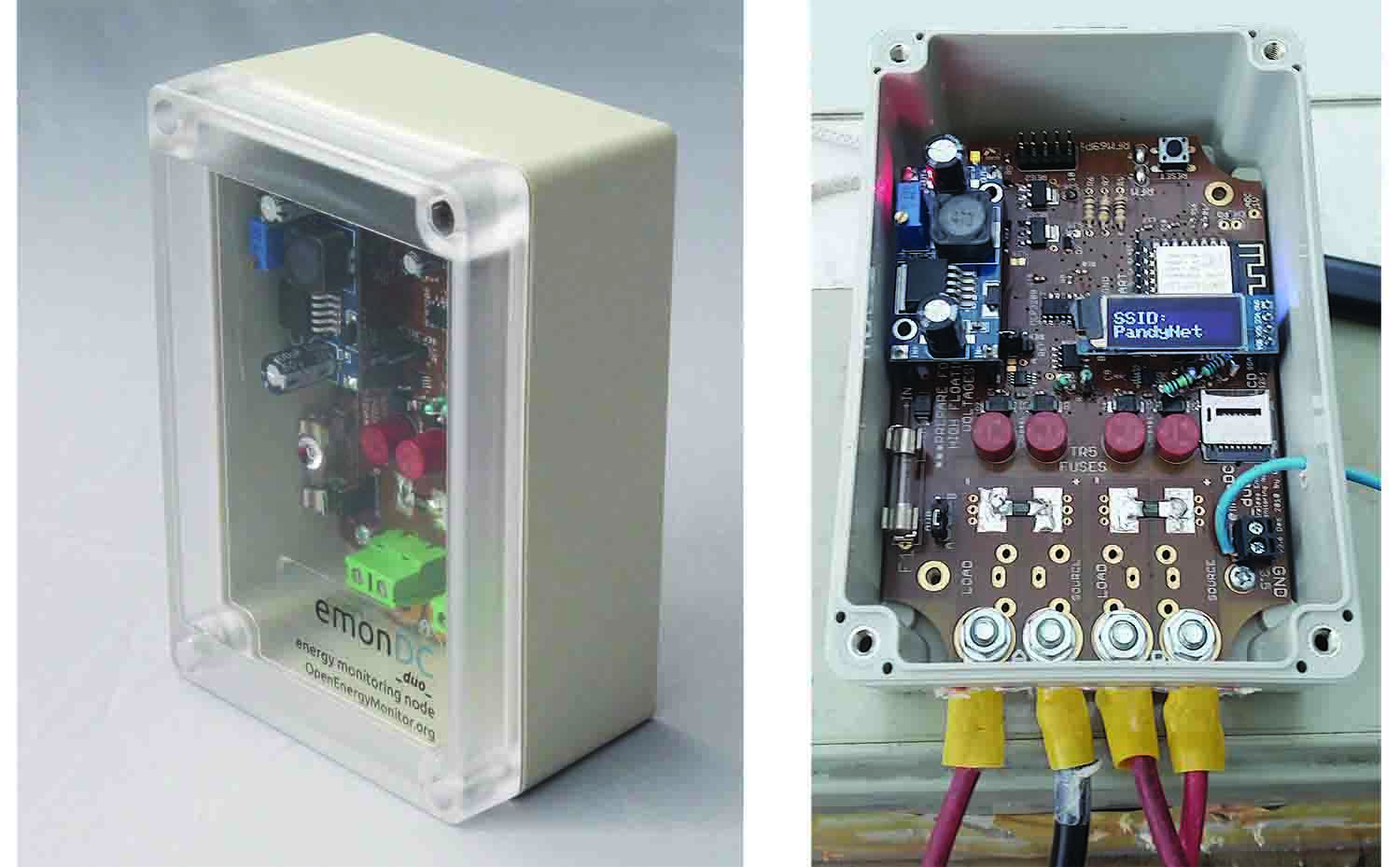Introducing emonDC
emonDC is a project aiming to develop DC current and voltage measuring tools compatible with OpenEnergyMonitor.org project. The main board in development is emonDCduo, a dual-channel DC monitor, WiFi enabled, aimed at solar/battery systems. emonDC has been developed by Daniel Bates.
emonDC development kits are now available in the OpenEnergyMonitor Store.

Target Uses
- 12V, 24V and 48V Solar PV systems, up to 64.4V max
- Battery monitoring.
- Remote DC data-logging.
Documentation on the unit, and on DC monitoring theory, is contained at the Github repo.
Features
- Two-channel high or low-side DC current and voltage sensing, up to 64.4V or 75V, suitable for a wide range of extra low voltage generator/battery systems.
- 50Amps onboard shunt rating or 1000A external shunt rating.
- Hall-effect current sensor footprint alternative for isolated current only measurement.
- Waterproof, clear-top plastic case.
- 128 x 32 OLED display.
- WiFi Connectivity.
- Low-power mode (10mA draw).
- Accurate 12-bit ADC.
- Over-voltage and reverse voltage protected (fuses).
Also, it can function as an independent unit, self-powered using an onboard buck voltage converter powered from a measurement channel. Data can be stored locally to a MicroSD card, keeping time with an on-board RTC and coin-cell. RFM69 based radio transmission is possible through a RFM69Pi module. For accuracy, the voltage sensing resistors and other reference voltage resistors are through hole, for easier modification, ensuring the option of very high resolution at low voltages. The I2C ports can connect control boards for power management, GPIO expander modules, or can forward data to a charge controller module. Skipping wireless transmission altogether, a standard 6-pin UART header is available.

Hardware Options
emonDCduo as designed here has shunt, termination, power-supply and other module options. See this demo video of the options.
Selection process
To help users with their purchase, a few options are available at the shop page. A specification process is required to purchase a unit, based on the installation context.
A recommended process would be something like:
- Find the required Amperage of the target channels.
- Select shunt on shop page exceeding the maximum expected current.
- Select cable mounting, ring terminals require crimping, screw terminals are convenient.
- Select power supply option. If the unit is powered from a measurement channel, then a DC-DC buck regulator is required. I the unit is powered from an external 5V PSU, then wires need connecting to a 5.08mm terminal block on board.
- Check the remaining options on the store page.
Firmware
The firmware is based on emonESP, and detailed instructions on compiling and uploading the firmware can be found in the emonESP documentation.

Other Customisation
Below are a set of images outlining some other customisations.
- GND connections, for the power-supply earth with a 4mm ring terminal on a mount. The terminal block for a gnd connection or shunt-lead shielding, if used.
- 5V input location.
- Power Select header, for bringing power into an on-board buck regulator, if used.
- Reference voltage and line voltage divider resistors.
- Shunt amplifier ‘reference select’ headers, for uni or bi-directional measurement.. Typically generator (uni-directional and battery (bi-directional).
- RFM69Pi headers.
- 3D Printed Case.
- Lightning protection using Gas Discharge Tube (GDT) (external link).
Online Support
Find answers, post questions, or message Dan directly via the Community Forum. Username @danbates
EmonDC Github Repo: Hardware & Fimrware
To engage in discussion regarding this post, please post on our Community Forum.